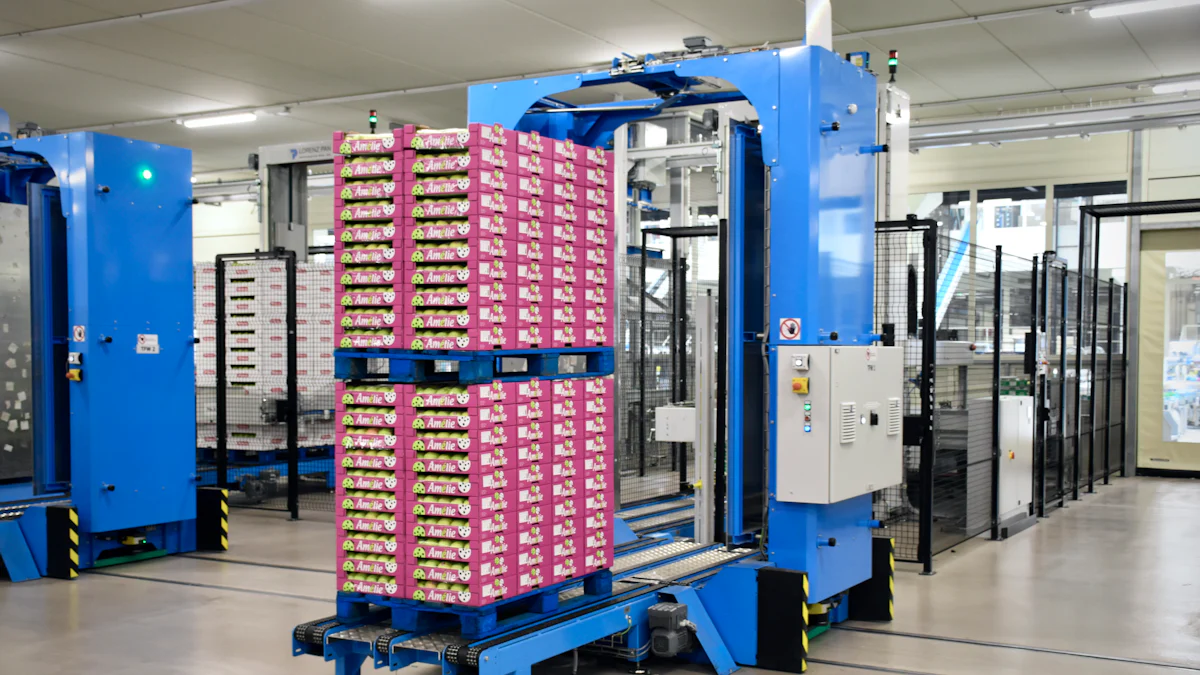The Rise of Digital Logistics: Market Predictions for 2024-2030

Digital logistics represents a transformative approach to managing supply chains through advanced technologies. This shift enhances efficiency, reduces costs, and improves customer satisfaction. Organizations embracing digital transformation in logistics report significant benefits. For instance, 87 percent of shippers have maintained or grown their technology investments since 2020. The timeframe from 2024 to 2030 will witness substantial growth in this sector. The global digital logistics market size was valued at $24.8 billion in 2022 and is projected to reach $155.3 billion by 2032, growing at a CAGR of 20.4%.
Market Dynamics in Digital Logistics

Key Trends in Digital Logistics
Adoption of AI and Machine Learning
AI and Machine Learning (ML) are transforming logistics operations. These technologies enable predictive analytics, which helps in forecasting demand and optimizing inventory levels. Autonomous vehicles and drones, powered by AI, are enhancing last-mile delivery efficiency. Major firms leverage AI and ML for real-time data analysis, improving decision-making capabilities.
Blockchain Technology in Logistics
Blockchain technology ensures greater transparency and security in supply chain operations. This technology provides an immutable ledger, which records all transactions. Companies use blockchain to track shipments and verify the authenticity of products. This reduces fraud and enhances trust among stakeholders.
IoT and Real-time Tracking
The Internet of Things (IoT) simplifies product storage and ensures efficient warehouse management. IoT devices provide real-time tracking and monitoring of shipments. This enhances supply chain visibility and effectiveness. Firms integrate IoT with other digital logistics solutions to optimize transportation management and inventory tracking.
Market Drivers
Increasing E-commerce Activities
E-commerce activities are driving the growth of digital logistics. Online shopping requires efficient and timely delivery of products. Digital logistics solutions enable companies to meet these demands. Advanced technologies like AI and IoT enhance the efficiency of e-commerce supply chains.
Demand for Faster Delivery
Consumers demand faster delivery times. Companies adopt digital logistics solutions to meet these expectations. Technologies like autonomous vehicles and drones facilitate quick and efficient deliveries. Real-time tracking systems provide customers with accurate delivery information.
Cost Efficiency and Optimization
Digital logistics solutions reduce operational expenses. AI and ML optimize processes like transportation management and warehouse operations. Blockchain technology ensures transparency, reducing the risk of fraud. IoT devices enhance supply chain visibility, leading to better decision-making and cost savings.
Market Restraints
Cybersecurity Concerns
Cybersecurity concerns pose a significant challenge to digital logistics. The integration of advanced technologies increases the risk of cyber-attacks. Companies must invest in robust cybersecurity measures to protect sensitive data. Ensuring data security remains a top priority for digital logistics providers.
High Initial Investment
The adoption of digital logistics solutions requires high capital investments. Small and medium-sized enterprises (SMEs) may find it challenging to afford these technologies. The cost of implementing AI, IoT, and blockchain can be prohibitive. Companies need to evaluate the return on investment before adopting these solutions.
Regulatory Challenges
Regulatory challenges hinder the growth of digital logistics. Different regions have varying regulations regarding data privacy and security. Companies must comply with these regulations to operate effectively. Navigating the complex regulatory landscape requires significant effort and resources.
Market Opportunities
Emerging Markets
Emerging markets present significant growth potential for digital logistics. Countries in Asia-Pacific, Latin America, and Africa are rapidly adopting advanced technologies. These regions experience increased e-commerce activities and demand for efficient supply chain solutions. Companies investing in these markets can capitalize on the growing need for digital logistics solutions.
Technological Advancements
Technological advancements drive the evolution of digital logistics. Innovations in AI, blockchain, and IoT enhance operational efficiency and transparency. AI and ML enable predictive analytics and autonomous delivery systems. Blockchain technology ensures secure and transparent transactions. IoT devices provide real-time tracking and monitoring of shipments. These advancements optimize supply chain management and reduce operational costs.
Strategic Partnerships and Collaborations
Strategic partnerships and collaborations accelerate the growth of digital logistics. Companies form alliances to leverage each other's strengths and capabilities. Collaborations with technology providers enable the integration of advanced solutions. Partnerships with logistics firms enhance service offerings and expand market reach. These strategic initiatives drive innovation and competitiveness in the digital logistics market.
Market Forecasts
Revenue Projections
Revenue projections for the digital logistics market indicate substantial growth. The market size was valued at $24.8 billion in 2022. Analysts project it to reach $155.3 billion by 2032. This represents a compound annual growth rate (CAGR) of 20.4%. The increasing adoption of digital logistics solutions drives this revenue growth.
Growth Rate Analysis
The digital logistics market exhibits a robust growth rate. The CAGR of 20.4% highlights the rapid expansion of the sector. Factors such as technological advancements and increasing e-commerce activities contribute to this growth. The demand for efficient and transparent supply chain solutions fuels the market's upward trajectory.
Key Market Segments
Key market segments in digital logistics include transportation management, warehouse management, and supply chain management. Transportation management solutions optimize route planning and delivery schedules. Warehouse management systems enhance inventory control and storage efficiency. Supply chain management platforms provide end-to-end visibility and coordination. These segments play a crucial role in the overall growth of the digital logistics market.
Market Segmentation
By Technology
AI and Machine Learning
AI and Machine Learning (ML) revolutionize logistics operations. These technologies enable predictive analytics, which helps in demand forecasting and inventory optimization. Autonomous vehicles and drones, powered by AI, enhance last-mile delivery efficiency. Companies leverage AI and ML for real-time data analysis, improving decision-making capabilities.
Blockchain
Blockchain technology ensures greater transparency and security in supply chain operations. This technology provides an immutable ledger that records all transactions. Companies use blockchain to track shipments and verify product authenticity. Blockchain reduces fraud and enhances trust among stakeholders.
IoT
The Internet of Things (IoT) simplifies product storage and ensures efficient warehouse management. IoT devices provide real-time tracking and monitoring of shipments. This enhances supply chain visibility and effectiveness. Firms integrate IoT with other digital logistics solutions to optimize transportation management and inventory tracking.
By Application
Transportation Management
Transportation management solutions optimize route planning and delivery schedules. These systems enhance fleet management and reduce fuel consumption. Companies use digital logistics tools to monitor vehicle performance and ensure timely deliveries. Real-time tracking systems provide accurate delivery information to customers.
Warehouse Management
Warehouse management systems improve inventory control and storage efficiency. These solutions automate various warehouse operations, such as picking, packing, and shipping. Digital logistics tools enable real-time inventory tracking and reduce human errors. Companies achieve cost savings and operational efficiency through advanced warehouse management systems.
Supply Chain Management
Supply chain management platforms provide end-to-end visibility and coordination. These solutions enhance collaboration among supply chain partners. Companies use digital logistics tools to monitor supply chain activities and identify potential disruptions. Advanced technologies like AI and IoT improve supply chain efficiency and resilience.
By End-User
Retail and E-commerce
Retail and e-commerce sectors drive the demand for digital logistics solutions. Online shopping requires efficient and timely delivery of products. Digital logistics tools enable companies to meet these demands. Advanced technologies like AI and IoT enhance the efficiency of e-commerce supply chains.
Manufacturing
Manufacturing industries benefit from digital logistics solutions. These tools optimize production schedules and ensure timely delivery of raw materials. Companies use digital logistics to monitor inventory levels and reduce production downtime. Advanced technologies improve manufacturing efficiency and reduce operational costs.
Healthcare
Healthcare sectors require efficient and reliable logistics solutions. Digital logistics tools ensure the timely delivery of medical supplies and equipment. Companies use these solutions to monitor the condition of sensitive products, such as vaccines. Advanced technologies enhance supply chain visibility and ensure compliance with regulatory standards.
Regional Analysis

North America
Market Size and Growth
North America holds a significant share in the digital logistics market. The region's market size reached $8.5 billion in 2022. Analysts project a growth rate of 18.2% CAGR from 2024 to 2030. The increasing adoption of advanced technologies drives this growth.
Key Players
Major players in North America include FedEx, UPS, and Amazon Logistics. These companies invest heavily in AI, IoT, and blockchain technologies. FedEx utilizes predictive analytics for demand forecasting. UPS integrates IoT devices for real-time tracking. Amazon Logistics employs autonomous vehicles for last-mile delivery.
Regional Trends
North America experiences several key trends in digital logistics. The region sees a rise in e-commerce activities, leading to increased demand for efficient supply chain solutions. Companies focus on sustainability goals, such as Aramex introducing electric motorcycles for last-mile delivery. The integration of AI and IoT enhances operational efficiency and transparency.
Europe
Market Size and Growth
Europe's digital logistics market shows robust growth. The market size stood at $6.3 billion in 2022. Projections indicate a CAGR of 17.5% from 2024 to 2030. The demand for streamlined supply chain operations fuels this growth.
Key Players
Prominent players in Europe include DHL, DB Schenker, and Kuehne + Nagel. DHL leverages blockchain technology for secure transactions. DB Schenker uses AI-powered systems for inventory management. Kuehne + Nagel integrates IoT devices for real-time shipment monitoring.
Regional Trends
Europe witnesses several regional trends in digital logistics. The region focuses on reducing carbon emissions and enhancing sustainability. Companies adopt electric vehicles and renewable energy sources. The integration of AI and ML enables predictive analytics and autonomous delivery systems. The COVID-19 pandemic accelerated the adoption of digital solutions, enhancing efficiency and decision-making capabilities.
Asia-Pacific
Market Size and Growth
Asia-Pacific represents a rapidly growing market for digital logistics. The market size reached $7.1 billion in 2022. Analysts forecast a CAGR of 20.8% from 2024 to 2030. The region's increasing e-commerce activities drive this growth.
Key Players
Key players in Asia-Pacific include Alibaba Group, JD Logistics, and Nippon Express. Alibaba Group utilizes AI for real-time data analysis. JD Logistics employs autonomous vehicles for efficient deliveries. Nippon Express integrates blockchain technology for supply chain transparency.
Regional Trends
Asia-Pacific experiences several notable trends in digital logistics. The region sees a surge in online shopping, leading to higher demand for efficient logistics solutions. Companies invest in advanced technologies like AI, blockchain, and IoT. Strategic partnerships and collaborations enhance service offerings and expand market reach. Technological advancements drive innovation and competitiveness in the region.
Rest of the World
Market Size and Growth
The digital logistics market in the Rest of the World (RoW) shows promising growth. The market size reached $3.9 billion in 2022. Analysts project a compound annual growth rate (CAGR) of 19.1% from 2024 to 2030. The adoption of advanced technologies drives this expansion. Emerging economies in Latin America, Africa, and the Middle East contribute significantly to this growth.
Key Players
Several key players dominate the digital logistics market in the RoW region. Aramex stands out with its innovative use of electric motorcycles for last-mile delivery. This initiative aligns with sustainability goals and aims for net-zero emissions by 2050. Agility Logistics leverages AI and IoT to enhance supply chain transparency and efficiency. CEVA Logistics integrates blockchain technology to ensure secure and transparent transactions.
Regional Trends
The RoW region experiences several notable trends in digital logistics. The COVID-19 pandemic accelerated the adoption of digital solutions. Companies now utilize automation, data analytics, and AI-powered systems for efficient inventory management.
Emerging markets in Latin America, Africa, and the Middle East show increased e-commerce activities. This surge drives the demand for streamlined supply chain operations. Companies invest in advanced technologies like AI, blockchain, and IoT to meet evolving customer expectations. These technologies enable faster, transparent, and sustainable logistics solutions.
Sustainability remains a key focus in the RoW region. Companies adopt electric vehicles and renewable energy sources to reduce carbon emissions. For instance, Aramex introduced electric motorcycles in the UAE to enhance last-mile delivery sustainability.
Technological advancements drive innovation and competitiveness in the RoW digital logistics market. AI and ML enable predictive analytics, optimizing demand forecasting and inventory levels. Blockchain technology ensures secure and transparent transactions, reducing fraud. IoT devices provide real-time tracking and monitoring of shipments, enhancing supply chain visibility.
Strategic partnerships and collaborations also play a crucial role. Companies form alliances to leverage each other's strengths and capabilities. Collaborations with technology providers enable the integration of advanced solutions. Partnerships with logistics firms enhance service offerings and expand market reach.
Competitive Landscape
Major Players
Company Profiles
The digital logistics market features several prominent players. IBM Corporation leads with its advanced AI and blockchain solutions. Oracle Corporation excels in supply chain management software. SAP SE offers comprehensive logistics platforms. Samsung Electronics Co. Ltd. integrates IoT devices for real-time tracking. Advantech Corporation focuses on industrial IoT applications. Honeywell International Inc. provides automation and control solutions. HCL Technologies Limited delivers IT services and consulting. Tech Mahindra Limited specializes in digital transformation services.
Market Share Analysis
IBM Corporation holds a significant market share due to its innovative technologies. Oracle Corporation and SAP SE also command substantial shares. Samsung Electronics Co. Ltd. and Advantech Corporation continue to expand their presence. Honeywell International Inc. and HCL Technologies Limited maintain strong positions. Tech Mahindra Limited shows steady growth in the market.
Recent Developments
IBM Corporation recently launched a new AI-powered logistics platform. Oracle Corporation introduced a blockchain-based supply chain solution. SAP SE enhanced its logistics software with predictive analytics. Samsung Electronics Co. Ltd. developed advanced IoT devices for shipment tracking. Advantech Corporation partnered with logistics firms to integrate IoT solutions. Honeywell International Inc. unveiled new automation tools for warehouses. HCL Technologies Limited expanded its digital logistics services. Tech Mahindra Limited collaborated with technology providers to innovate logistics solutions.
Competitive Strategies
Mergers and Acquisitions
IBM Corporation acquired several startups to enhance its AI capabilities. Oracle Corporation merged with smaller firms to expand its blockchain offerings. SAP SE acquired companies specializing in predictive analytics. Samsung Electronics Co. Ltd. purchased IoT technology firms. Advantech Corporation merged with industrial IoT providers. Honeywell International Inc. acquired automation technology companies. HCL Technologies Limited expanded through strategic acquisitions. Tech Mahindra Limited merged with digital transformation firms.
Partnerships and Collaborations
IBM Corporation formed alliances with logistics firms to implement AI solutions. Oracle Corporation collaborated with blockchain technology providers. SAP SE partnered with companies to integrate predictive analytics. Samsung Electronics Co. Ltd. worked with IoT device manufacturers. Advantech Corporation teamed up with logistics companies for IoT integration. Honeywell International Inc. collaborated with warehouse automation firms. HCL Technologies Limited partnered with IT service providers. Tech Mahindra Limited joined forces with technology innovators.
Product Innovations
IBM Corporation launched an AI-driven logistics platform. Oracle Corporation introduced a blockchain-based supply chain tool. SAP SE released software with enhanced predictive analytics. Samsung Electronics Co. Ltd. developed new IoT tracking devices. Advantech Corporation created advanced industrial IoT solutions. Honeywell International Inc. unveiled automation tools for warehouses. HCL Technologies Limited rolled out digital logistics services. Tech Mahindra Limited innovated with new logistics technologies.
The digital logistics market will experience significant growth from 2024 to 2030. Key trends include the adoption of AI, blockchain, and IoT technologies. These advancements enhance efficiency, transparency, and cost savings in logistics operations.
The future outlook for digital logistics appears promising. North America will retain dominance due to its robust IT infrastructure and skilled workforce. The Asia-Pacific region will witness the highest growth rate, driven by emerging technologies and increasing e-commerce activities.
In conclusion, the digital logistics market will continue to evolve rapidly. Companies investing in advanced technologies and strategic partnerships will lead the way. The market's expansion will bring new opportunities and challenges, shaping the future of global supply chains.
See Also
Navigating Tomorrow: Logistics Transformation through Digital Innovation
Artificial Intelligence in Logistics: Transforming Future Supply Chains
Unraveling the Effects: Trends in Logistics Risk Analysis
Revolutionizing Logistics: Exploring Future Technology Advancements
Virtual Replicas: Shaping the Future of Supply Chain Operations
